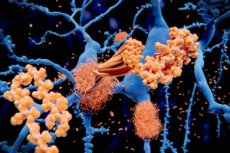New publications
Target found to neutralize toxic proteins in Parkinson's disease
Last reviewed: 02.07.2025

All iLive content is medically reviewed or fact checked to ensure as much factual accuracy as possible.
We have strict sourcing guidelines and only link to reputable media sites, academic research institutions and, whenever possible, medically peer reviewed studies. Note that the numbers in parentheses ([1], [2], etc.) are clickable links to these studies.
If you feel that any of our content is inaccurate, out-of-date, or otherwise questionable, please select it and press Ctrl + Enter.

Researchers from UAB (Autonomous University of Barcelona) have identified a site in early aggregates of the alpha-synuclein protein that can be targeted to prevent it from turning into toxic amyloid fibrils that accumulate in the brains of people with Parkinson's disease.
The discovery was recently published in the Journal of the American Chemical Society in a study that deepens the understanding of the structural properties of these initial aggregates, or oligomers, and opens the door to developing new therapeutic strategies to inactivate them.
The study was conducted by scientists Salvador Ventura, Jaime Santos, Jordi Pujols and Irantzu Palhares from the Institute of Biotechnology and Biomedicine (IBB) and the Department of Biochemistry and Molecular Biology.
Alpha-synuclein aggregation is a hallmark of Parkinson's disease and other synucleinopathies. It is a dynamic process in which the protein self-assembles to form oligomers that eventually develop into toxic amyloid fibrils that accumulate in the patient's brain.
Alpha-synuclein oligomers play a key role in the development and progression of the disease and are therefore promising therapeutic and diagnostic targets, especially in the early stages of the disease. However, their transient and highly dynamic nature limits the study of their structure and complicates the development of therapies aimed at blocking them.
In a previous study, the researchers found that a small molecule, the bacterial peptide PSMα3, inhibits alpha-synuclein aggregation by binding to oligomers, blocking fibrilization and suppressing neurotoxicity. In this study, they determined where, how, and when this binding occurs in oligomers, identifying a key region for the structural conversion process associated with the pathogenesis of Parkinson's disease.
"We have identified a structural sequence that is required to convert oligomers into fibrils, thereby opening a new field for the development of molecules that target oligomers. Using this field, we can design new molecules that mimic the properties of PSMα3 with much greater affinity and potency," explains Ventura, director of the Protein Folding and Conformational Diseases Research Group at IBB and coordinator of the study.
Combining structural, biophysical, and biochemical analyses, the researchers found that PSMα3 acts by binding to one end of alpha-synuclein (the N-terminus), which regulates the process of converting oligomers into fibrils. When bound, the peptide covers two small adjacent regions of the protein, P1 and P2, which have been shown to be critical for this pathological transition.
"This region is an ideal therapeutic target because it is only recognized by peptides when they are part of oligomers, allowing us to target the aggregates without affecting the functional monomeric form of alpha-synuclein, which is essential for normal brain function," Ventura says.
The study also has implications for better understanding the molecular mechanisms of the inherited form of Parkinson's disease. This form, which typically strikes people at a younger age, is often associated with mutations located in the P2 region of alpha-synuclein, such as the G51D mutation, which causes one of the most aggressive forms of the disease.
The researchers showed that the G51D mutation in the identified critical region causes conformational fluctuations that slow down the conversion of oligomers into fibrils. This slowdown leads to the accumulation of toxic, long-lived oligomers that are inefficiently processed by molecular chaperones that attempt to disaggregate them.
"Our discovery could lead to the development of specific peptides that can target these mutated forms of alpha-synuclein, and therefore to a personalized approach to therapy for those suffering from the inherited form of Parkinson's disease. We are already working on developing these molecules," says Ventura.
